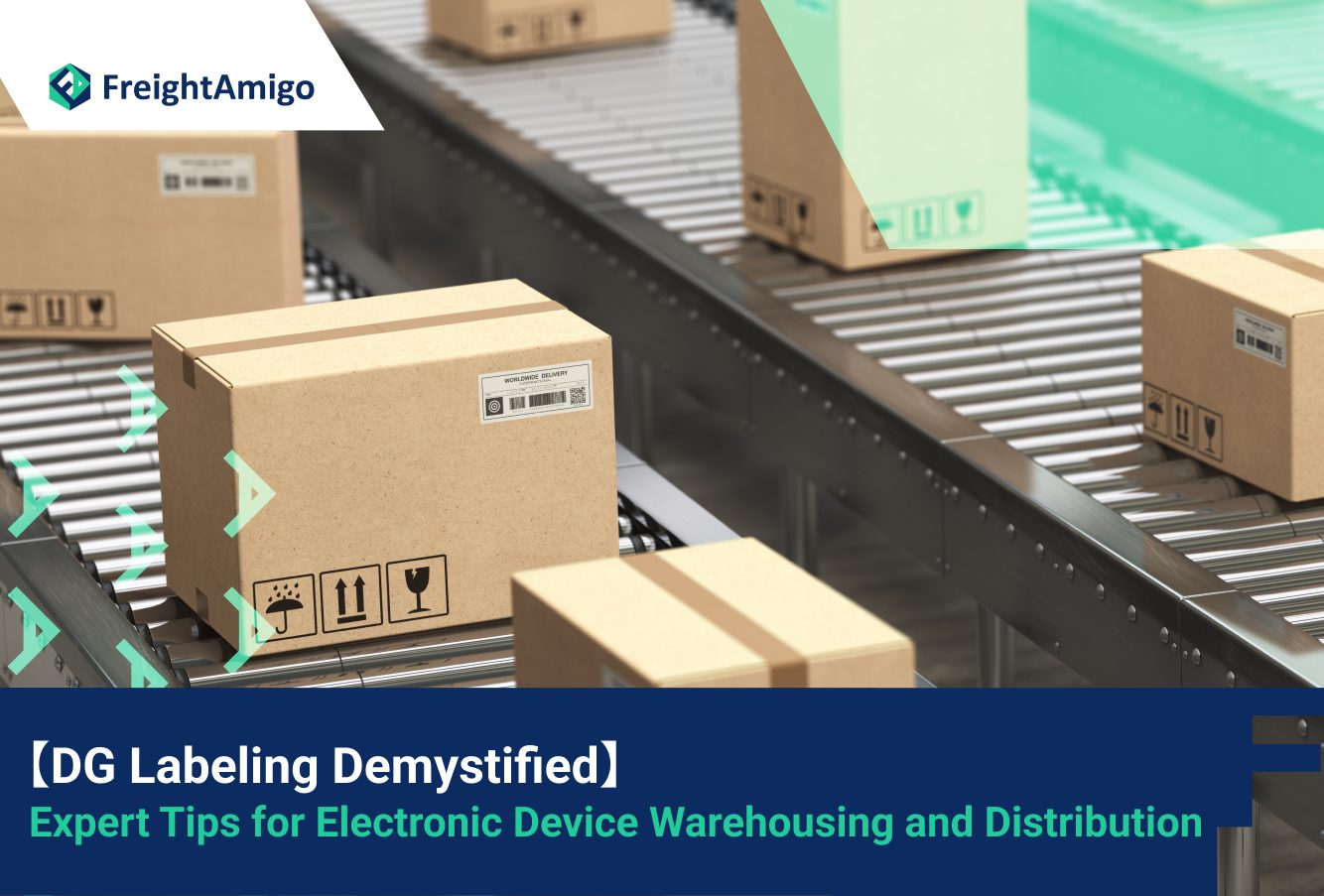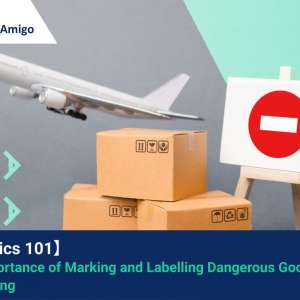DG labeling is a crucial aspect of electronic device warehousing and distribution. It ensures the safe handling and transportation of dangerous goods, protecting both the people involved in the process and the environment. In this article, we will explore the importance of DG labeling in electronic device warehousing and distribution, regulatory standards that need to be adhered to, common labeling requirements, best practices, and tools and resources to ensure compliance.
Author Name: Aiden Ng– Marketing Analyst at FreightAmigo
Want to compare the best Express, Air Freight, Sea Freight, Rail Freight & Trucking rates so as to have better control on cost?
Importance of DG Labeling in Electronic Device Warehousing and Distribution
When it comes to electronic device warehousing and distribution, DG labeling plays a vital role in ensuring the safety of everyone involved. Electronic devices often contain lithium-ion batteries, which are classified as dangerous goods due to their potential to ignite or explode. Improper handling or storage of these devices can lead to serious accidents and injuries.
DG labeling provides clear identification and communication about the hazardous nature of the products being stored or transported. This helps warehouse workers, drivers, and other personnel to handle the goods safely, minimizing the risk of accidents. It also enables emergency responders to quickly identify and respond to any incidents involving dangerous goods.
Furthermore, proper DG labeling ensures compliance with regulations set forth by authorities such as the International Air Transport Association (IATA) and the Department of Transportation (DOT). Non-compliance can result in legal consequences, fines, and damage to a company’s reputation. Therefore, it is crucial for electronic device warehousing and distribution companies to prioritize DG labeling.
Regulatory Standards for DG Labeling
To maintain safety and standardization in the handling and transportation of dangerous goods, regulatory bodies have established specific standards for DG labeling. These standards ensure that the labeling information is consistent, easily understood, and universally recognized.
The International Air Transport Association (IATA) has developed the Dangerous Goods Regulations (DGR) as a global standard for air transport of dangerous goods. It provides guidelines for the proper labeling and packaging of hazardous materials, including electronic devices. The Department of Transportation (DOT) in the United States also has its own regulations, which must be followed for transportation within the country.
Companies involved in electronic device warehousing and distribution must comply with these regulations to ensure the safety of their operations. It is essential to stay updated with any changes or amendments to these standards to avoid any compliance issues.
Common DG Labeling Requirements for Electronic Devices
When it comes to DG labeling for electronic devices, there are several common requirements that need to be met. These requirements ensure that the dangerous goods are properly identified and handled throughout the warehousing and distribution process.
- Proper Labeling: Each package containing dangerous goods must be labeled with the appropriate hazard class labels. These labels provide information about the type of hazard the goods present, such as flammable, corrosive, or explosive.
- UN Number: Each hazardous material must be assigned a unique UN number, which indicates the specific substance or article being transported. This number helps in the identification and classification of the dangerous goods.
- Proper Shipping Name: The proper shipping name of the hazardous material must be clearly stated on the label. This name accurately identifies the substance or article being transported.
- Manufacturer’s Name and Address: The label should include the name and address of the manufacturer or distributor of the hazardous material. This information helps in identifying the responsible party in case of any issues or emergencies.
- Handling Instructions: The label should provide clear instructions on how to handle the package safely. This includes information on storage conditions, temperature restrictions, and any special precautions that need to be taken.
By following these common labeling requirements, electronic device warehousing and distribution companies can ensure that the dangerous goods are properly identified and handled throughout the supply chain.
Best Practices for DG Labeling in Warehousing and Distribution
To ensure compliance and safety in electronic device warehousing and distribution, it is important to follow best practices for DG labeling. These practices help in minimizing risks and maintaining efficient operations. Here are some expert tips to consider:
- Training and Education: Provide comprehensive training to warehouse personnel and drivers on DG labeling regulations and best practices. This ensures that everyone involved is aware of the requirements and knows how to handle dangerous goods safely.
- Standard Operating Procedures: Develop and implement standard operating procedures (SOPs) that outline the proper labeling and handling of dangerous goods. These SOPs should be regularly reviewed and updated to reflect any changes in regulations.
- Quality Control Checks: Establish a rigorous quality control process to ensure that all packages are properly labeled before being shipped. Regular inspections and audits should be conducted to identify and rectify any labeling errors or deficiencies.
- Use of Technology: Utilize labeling software and barcode scanning systems to streamline the labeling process and minimize human errors. These technologies can help automate the labeling process and ensure accuracy and consistency.
- Collaboration with Suppliers: Maintain open communication with suppliers to ensure that they are providing the necessary labeling information for the products being delivered. This collaboration helps in ensuring compliance and consistency throughout the supply chain.
By implementing these best practices, electronic device warehousing and distribution companies can ensure that their DG labeling processes are efficient, compliant, and prioritize the safety of their personnel and the environment.
Tools and Resources for DG Labeling Compliance
To facilitate DG labeling compliance in electronic device warehousing and distribution, several tools and resources are available. These tools help in simplifying the labeling process and staying up to date with regulatory requirements. Here are some recommended resources:
- Labeling Software: Invest in labeling software that is specifically designed for DG labeling. These software solutions provide pre-designed templates, incorporate the latest regulatory standards, and offer printing capabilities to ensure accurate and compliant labeling.
- Regulatory Guides and Manuals: Stay updated with the latest regulations by referring to regulatory guides and manuals provided by organizations such as the International Air Transport Association (IATA) and the Department of Transportation (DOT). These guides provide comprehensive information on DG labeling requirements and best practices.
- Training Programs: Enroll personnel in training programs that focus on DG labeling and compliance. Many organizations offer online courses and certifications that cover all aspects of dangerous goods handling and labeling.
- Industry Associations: Join industry associations that specialize in electronic device warehousing and distribution. These associations provide valuable resources, networking opportunities, and access to experts who can provide guidance on DG labeling compliance.
By utilizing these tools and resources, companies can ensure that they have the necessary support and knowledge to maintain DG labeling compliance in their operations.
Conclusion
DG labeling is a critical aspect of electronic device warehousing and distribution. It ensures the safe handling and transportation of dangerous goods, protecting the well-being of individuals and the environment. Compliance with regulatory standards, adherence to common labeling requirements, and implementation of best practices are essential for maintaining safety and efficiency in these operations. By utilizing the available tools and resources, companies can simplify the labeling process and stay up to date with the latest regulations. With proper DG labeling, electronic device warehousing and distribution companies can ensure the safe and secure transportation of their products.
There are different options for cargo transportation. If you want to choose the most convenient and suitable solution, it is best to have the full support of logistics experts! If you are planning to ship goods overseas, please go to the FreightAmigo page for inquiries.
【Import and Export Insights for 2024】 Exploring New Opportunities in Emerging Markets
===
If you have any inquiries on logistics/supply chain, feel free to contact FreightAmigo now:
Chat with us online OR
Phone : +852 28121686
WhatsApp: +852 27467829



